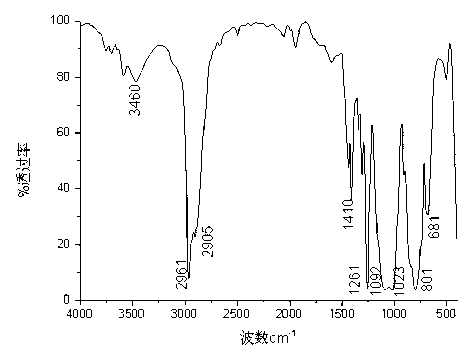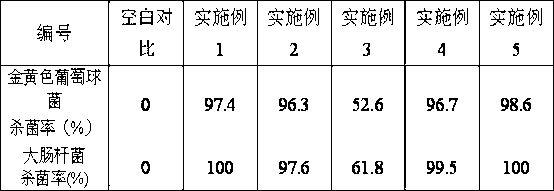Method for preparing organosilicon quaternary ammonium salt modified polyurethane resin for marine antifouling coating
A technology of organosilicon quaternary ammonium salt and polyurethane resin, which is applied in the field of organosilicon quaternary ammonium salt modified polyurethane resin, can solve problems such as poor compatibility, and achieve the effects of improving compatibility, good wear resistance, and reducing costs
- Summary
- Abstract
- Description
- Claims
- Application Information
AI Technical Summary
Problems solved by technology
Method used
Image
Examples
preparation example Construction
[0016] The preparation method of organic silicon quaternary ammonium salt modified polyurethane resin for marine antifouling coating of the present invention comprises the following steps:
[0017] 1. Preparation of dihydroxy-terminated organosilicon quaternary ammonium salt
[0018] 1 mole part of 1,3-bis[3-(1-methoxy-2-hydroxypropoxy)propyl]-tetramethyldisiloxane, 3-18 mole parts of γ-chloropropylmethyl Mix dimethoxysilane, 21-72 mole parts dimethyldimethoxysilane, and 30-90 mole parts deionized water, add 0.5-1.5 mole parts of strong acid catalyst under nitrogen protection, and heat up to 50-60°C , After reacting for 0.5-1h, remove the small molecule methanol produced by the reaction; then raise the temperature to 70°C, continue the reaction for 4-6h, adjust the pH to 7, control the pressure at 70°C to 5mmHg, and carry out vacuum distillation into the residue No bubbles are obtained containing chloropropyl dihydroxyl-terminated polysiloxane; the resulting chloropropyl-con...
Embodiment 1
[0030] (1) Preparation of dihydroxy-terminated organosilicon quaternary ammonium salt
[0031] 1 mole part of 1,3-bis[3-(1-methoxy-2-hydroxypropoxy)propyl]-tetramethyldisiloxane, 9 mole parts of γ-chloropropylmethyl dimethyl Oxysilane, 21 molar parts of dimethyldimethoxysilane, and 30 molar parts of deionized water were mixed evenly. Under the protection of nitrogen, 0.5 molar parts of trifluoromethanesulfonic acid were added, and the temperature was raised to 50 ° C. After reacting for 1 hour, pumping Remove the small molecule methanol produced by the reaction; then raise the temperature to 70°C, continue the reaction for 4 hours, adjust the pH to 7, and control the pressure at 5mmHg at 70°C to carry out vacuum distillation until there is no bubble in the residue to obtain the chloropropyl-containing dihydroxy-capped product. Terminated polysiloxane; mix the obtained chloropropyl-containing bishydroxyl-terminated polysiloxane with 9 molar parts of dodecyldimethyl tertiary ami...
Embodiment 2
[0037] (1) Preparation of dihydroxy-terminated organosilicon quaternary ammonium salt
[0038] 1 mole part of 1,3-bis[3-(1-methoxy-2-hydroxypropoxy)propyl]-tetramethyldisiloxane, 6 mole parts of γ-chloropropylmethyl dimethyl Oxysilane, 24 mole parts of dimethyldimethoxysilane, and 30 mole parts of deionized water were mixed evenly. Under the protection of nitrogen, 0.5 mole parts of trifluoromethanesulfonic acid was added, and the temperature was raised to 60 ° C. After reacting for 1 hour, pumping Remove the small molecule methanol produced by the reaction; then raise the temperature to 70°C, continue the reaction for 6 hours, adjust the pH to 7, and control the pressure at 5mmHg at 70°C to carry out vacuum distillation until there is no bubble in the residue to obtain the chloropropyl-containing dihydroxy-sealed product. Terminated polysiloxane; the resulting chloropropyl-containing bishydroxyl-terminated polysiloxane is mixed with 6 molar parts of dodecyldimethyl tertiary a...
PUM
| Property | Measurement | Unit |
|---|---|---|
| Molecular weight | aaaaa | aaaaa |
Abstract
Description
Claims
Application Information
 Login to View More
Login to View More - R&D
- Intellectual Property
- Life Sciences
- Materials
- Tech Scout
- Unparalleled Data Quality
- Higher Quality Content
- 60% Fewer Hallucinations
Browse by: Latest US Patents, China's latest patents, Technical Efficacy Thesaurus, Application Domain, Technology Topic, Popular Technical Reports.
© 2025 PatSnap. All rights reserved.Legal|Privacy policy|Modern Slavery Act Transparency Statement|Sitemap|About US| Contact US: help@patsnap.com


